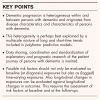Understanding and predicting the longitudinal course of dementia
- PMID: 30557268
- PMCID: PMC6380437
- DOI: 10.1097/YCO.0000000000000482
Understanding and predicting the longitudinal course of dementia
Abstract
Purpose of review: To date, most research in dementia has focused either on the identification of dementia risk prediction or on understanding changes and predictors experienced by individuals before diagnosis. Despite little is known about how individuals change after dementia diagnosis, there is agreement that changes occur over different time scales and are multidomain. In this study, we present an overview of the literature regarding the longitudinal course of dementia.
Recent findings: Our review suggests the evidence is scarce and findings reported are often inconsistent. We identified large heterogeneity in dementia trajectories, risk factors considered and modelling approaches employed. The heterogeneity of dementia trajectories also varies across outcomes and domains investigated.
Summary: It became clear that dementia progresses very differently, both between and within individuals. This implies an average trajectory is not informative to individual persons and this needs to be taken into account when communicating prognosis in clinical care. As persons with dementia change in many more ways during their patient journey, heterogeneous disease progressions are the result of disease and patient characteristics. Prognostic models would benefit from including variables across a number of domains. International coordination of replication and standardization of the research approach is recommended.
Similar articles
-
Right care, first time: a highly personalised and measurement-based care model to manage youth mental health.Med J Aust. 2019 Nov;211 Suppl 9:S3-S46. doi: 10.5694/mja2.50383. Med J Aust. 2019. PMID: 31679171
-
Predictors of Driving Cessation in Dementia: Baseline Characteristics and Trajectories of Disease Progression.Alzheimer Dis Assoc Disord. 2018 Jan-Mar;32(1):57-61. doi: 10.1097/WAD.0000000000000212. Alzheimer Dis Assoc Disord. 2018. PMID: 28984640
-
Clinical decision trees for predicting conversion from cognitive impairment no dementia (CIND) to dementia in a longitudinal population-based study.Arch Clin Neuropsychol. 2011 Feb;26(1):16-25. doi: 10.1093/arclin/acq089. Epub 2010 Dec 8. Arch Clin Neuropsychol. 2011. PMID: 21147863
-
[Overview of standardised diagnostic instruments of dementia].Fortschr Neurol Psychiatr. 2003 Apr;71(4):187-98. doi: 10.1055/s-2003-38507. Fortschr Neurol Psychiatr. 2003. PMID: 12677552 Review. German.
-
The use of screening instruments for the detection of dementia.Neuroepidemiology. 1997;16(6):271-80. doi: 10.1159/000109697. Neuroepidemiology. 1997. PMID: 9430126 Review.
Cited by
-
Dementia caregiver burdens predict overnight hospitalization and hospice utilization.Palliat Support Care. 2023 Dec;21(6):1001-1015. doi: 10.1017/S1478951522001249. Palliat Support Care. 2023. PMID: 36263744 Free PMC article.
-
Microglial activation and tau burden predict cognitive decline in Alzheimer's disease.Brain. 2020 May 1;143(5):1588-1602. doi: 10.1093/brain/awaa088. Brain. 2020. PMID: 32380523 Free PMC article.
-
A comprehensive analysis of digital health-focused Living Labs: innovative approaches to dementia.Front Med (Lausanne). 2024 Jul 10;11:1418612. doi: 10.3389/fmed.2024.1418612. eCollection 2024. Front Med (Lausanne). 2024. PMID: 39050540 Free PMC article. Review.
-
A comparison of two approaches for modeling dementia progression in a changing patient context.Int J Geriatr Psychiatry. 2022 May;37(5):10.1002/gps.5706. doi: 10.1002/gps.5706. Int J Geriatr Psychiatry. 2022. PMID: 35393705 Free PMC article.
-
Health literacy in relation to web-based measurement of cognitive function in the home: UK Women's Cohort Study.BMJ Open. 2025 Mar 6;15(3):e092528. doi: 10.1136/bmjopen-2024-092528. BMJ Open. 2025. PMID: 40054868 Free PMC article.
References
-
- Fotuhi M, Hachinski V, Whitehouse PJ. Changing perspectives regarding late-life dementia. Nat Rev Neurol 2009; 5:649–658. - PubMed
-
- Livingston G, Sommerlad A, Orgeta V, et al. Dementia prevention, intervention, and care. Lancet 2017; 390:2673–2734. - PubMed
-
- Eldholm RS, Barca ML, Persson K, et al. Progression of Alzheimer's disease: a longitudinal study in Norwegian memory clinics. J Alzheimers Dis 2018; 61:1221–1232. - PubMed
-
- Singer JD, Willet JB. Applied longitudinal data analysis: modeling change and event occurrence. New York: Oxford University Press; 2003.
-
- Jutkowitz E, MacLehose RF, Gaugler JE, et al. Risk factors associated with cognitive, functional, and behavioral trajectories of newly diagnosed dementia patients. J Gerontol A Biol Sci Med Sci 2017; 72:251–258. - PMC - PubMed
-
This study used longitudinal data from PWD from NACC to study the predictors of multidimensional progression of dementia. Studying multiple outcomes simultaneously (in this case cognition and daily functioning) sets out this study from most other studies in the field. Also showing the impact of sociodemographic characteristics is both fairly unique and important.
Publication types
MeSH terms
LinkOut - more resources
Full Text Sources
Medical
Research Materials


